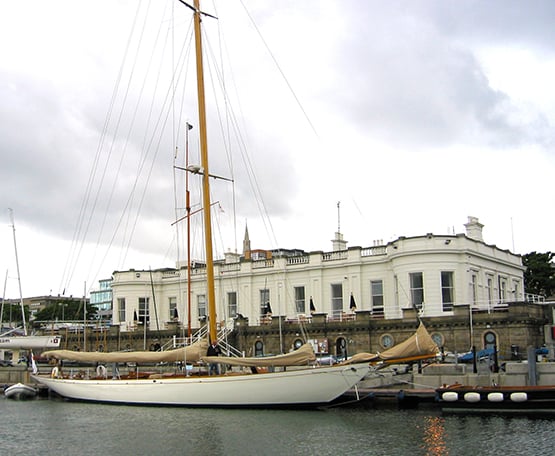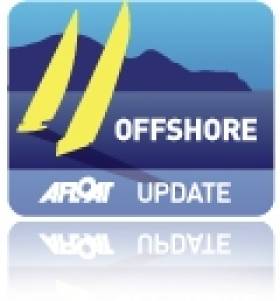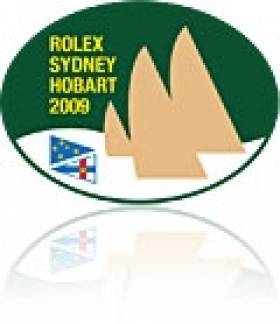Displaying items by tag: Rumball
The Legendary Start For Sydney’s Headlong Rush To Hobart
There’s nothing that really compares with the annual Rolex Sydney Hobart Race. While most of the more-populated parts of the world in the Northern Hemisphere are in their midwinter shutdown, somnolent and sluglike in a festival of consumer excess, away south of the Equator one of the most magnificent city harbours in the world is exuberantly celebrating outdoors in all its midsummer glory. And then it tops out the party with one of world sailing’s great spectacles. W M Nixon anticipates the Rolex Sydney Hobart Race 2015, which starts in full daylight in Australia an hour after this is posted at midnight on Christmas Day in Ireland.
With the Yuletide festivities scarcely put away, a group of extreme boats at the peak end of the hundred foot size limit - every last one of them owned and sailed by larger-than-life characters – comes roaring out of Sydney’s glorious harbour at the head of a magnificent fleet, a colossally varied collection of 108 craft in which every crew reckons they’re in with a chance. For although line honours for the biggies are what captures the headlines, for the dyed-in-the-wool enthusiasts the only real trophy in the thrash to Hobart is the Tattersall’s Cup for the overall winner on IRC Handicap.
A severe weather forecast of three days ago has now been watered down, but there’ll still be plenty of breeze at some stages to be going along with. The start is expected to be in a moderate to fresh northeasterly, stronger outside once they begin making southing down the Tasman Sea, with most boats chasing that elusive race-winning south-going current which may be anything up to ten miles offshore.
Then everything changes in the weather situation with an active front rolling up from the south and southwest, with strong headwinds – maybe gusting to 45 knots in the front itself – providing atrocious wind-over-tide conditions with the under-lying south-going current. There’ll be a lot of Christmas dinners spread out over the ocean……After that, the winds are forecast to fall away as the bulk of the fleet get to the Bass Strait, but overall the pundits are reckoning boats in the 60ft to 75ft size range are looking to be the favoured cohort, while George David’s Rambler 88 – with the legendary Brad Butterworth in the afterguard – is now looking good to give the hundred footers more than a few tense moments.
By the time you’re likely to be reading this on Saturday morning, the drama will already be unfolding on the other side of the world, and all sorts of newsfeeds will be available for the best armchair offshore racing of the year. Yet as a Rolex Sydney-Hobart Race addict, I’ll readily concede that the last thing addiction provides is a clear picture, so you can expect this anticipation to be something of a rose-tinted view.

The Rolex Sydney-Hobart Race – a classic course which is staging its 71st edition as 2015 draws to a close
But that said, the Rolex Sydney Hobart Race of 2014 will take some beating. It provided the glorious battle for line honours between the new Comanche and the continually-evolving Wild Oats XI, veteran owner and local favourite Bob Oatley’s originally 98ft Reichel Pugh Wild Oats XI of 2005 vintage, but modified almost every year since, such that by December 2014 she was a hundred footer. Against her, the big new fat girl, Jim and Kristy Hinze Clark’s JK-designed total hundred footer Comanche, so big and beamy you could fit two Wild Oats into her and still have room to spare.
Yet although all the heavy metal seemed to be on Comanche’s side, including having the formidable Kenny Read as skipper, in the end the skinny girl wriggled her way through some awkward conditions which Comanche loathed, and wriggled to such good effect that Wild Oats took line honours.

It’s reckoned you’d still have room to spare after fitting two of Wild Oats XI (left) into the very different hull of Comanche (right)
And then, to put the icing well and truly on the Hobart cake, as the various potential handicap winners were knocked out by the remorseless ticking of the clock, an overall winner emerged who was the very epitome of the true Australian ocean racing spirit. The veteran Farr 43 Wild Rose, owned successfully for many years by Roger Hickman, was on top of her immaculate form, and won the Tattersall’s Cup.
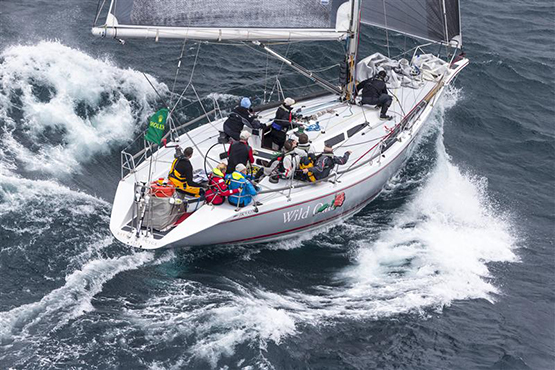
The true spirit of Australian offshore racing – Roger Hickman’s 28 year old Farr 43 Wild Rose (ex-Wild Oats) is defending champion in this year’s Rolex Sydney-Hobart race
And what was Wild Rose’s back-story? You just couldn’t make it up. She was one of the first boats to be called Wild Oats, brought to the Australian racing scene by a legendary entrepreneur called Bob Oatley who’d been so successful in business in Papua New Guinea that at one stage he was controlling 95% of the entire country’s GDP. And then, when local interests bought him out, he shifted operations back home to Australia, and created himself a new conglomerate business empire on an even large stage.
He found that the challenge of campaigning a serious offshore racer at the top end of the exuberant Australian offshore racing scene went perfectly with business. If the boat did well, enterprises like Robert Oatley Wines did well too. But regardless of that, it was fun. So although he’s looking into his 90s. Old Bob is as keen as ever on the whole crazy game, and with Mark Richards he has the perfect skipper/boat manager to maximize returns from the sheer entertainment provided by keeping Wild Oats XI up to the mark to fulfill her role as the people’s favourite.
The improvement project for 2015 was basically to re-position the mast. Now most folks, if they decide the mast is too far forward, they’d simply move it aft. But not the Wild Oats team. At its most fundamental, what they’ve done is keep the mast where it was, but they chopped off the bow - the chainsaw pix say it all - and then added a completely new longer slimmer bow. Try as you might, you can’t see the join…...

If you’re going to take the bow off the boat with a chainsaw, better make sure you’ve the owner there to do it with you. Mark Richards and Bob Oatley start the drastic surgery on Wild Oat XI
 You can’t even see the join….,Wild Oats with her new longer bow (right) with the old bow (left) kept in storage “in case the new one didn’t work” . But would you call that new stem a “clipper bow”?
You can’t even see the join….,Wild Oats with her new longer bow (right) with the old bow (left) kept in storage “in case the new one didn’t work” . But would you call that new stem a “clipper bow”?
Then, to keep her down to a hundred feet, they shortened and re-shaped the stern, such that the result of it all is the skinny girl is now super-slim. But thanks to the latest materials and some ferociously clever engineering and technology, Wild Oats is able to carry a mighty canting keel which keeps this torpedo of a boat upright and powering successfully along, in which mission she is further assisted by all sorts of canards and foils which can be deployed from multiple orifices.
Central to the whole story today, however, is the fact that the Hobart Race 2015 is the first real test of the completely re-vamped Wild Oats XI, and she’s yet again up against Comanche as a trial horse. But after such radical changes, naturally there are those who’ll question them. For a start, it has been noted that with the completely new bow section, the even longer bowsprit on WOXI is receiving additional support from a sort of solid strut from the stem which creates what some of us might describe as a clipper bow.
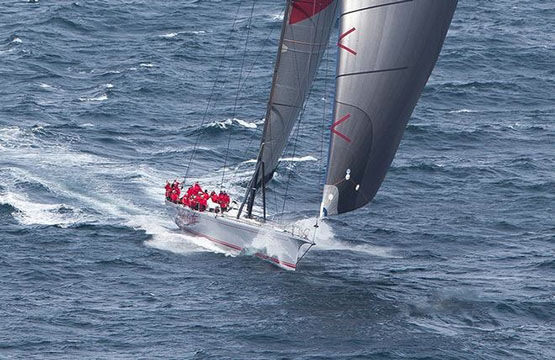
The re-configured Wild Oats XI is faster than ever, but what length is she?
And if you accept that this has indeed become a clipper bow of sorts, instead of a straight stem bow which happens to have a solid strut support for an unusually long bowsprit, then you’re accepting that Wild Oats’ hull has now become more than a hundred feet long, and therefore above the size limit for the Rolex Sydney-Hobart Race. At the time of writing, the Race Committee seemed to have accepted that Wild Oats still has a straight stem. But we can think of a few sea-lawyers who might possibly demur.
In the end, it’s a matter of definitions. Just recently, a Classic Boat magazine profile of the magnificent Fife-designed-and-built 1926 Fastnet Race line honours winner Hallowe’en revealed she is just over 71ft LOA, and something like 47ft when unladen on the waterline. The waterline length was fine, as it allowed some immersion in seagoing trim to stay within the Fastnet limit of 50ft LWL. But what’s with this 71ft plus in the LOA department, when the Fastnet Rule – set after the inaugural race of 1925 – clearly set the upper LOA limit at 70ft? Well, it seems that Hallowe’en is 70ft LOA on deck. And LOD was seen by many as being one and the same thing as LOA back in 1926. So now you know.
Hallowe’en, 1926 Fastnet Race Line Honours Winner, at the Royal Irish YC. While she was 70ft LOD to comply with the Fastnet Race maximum size, her hull LOA is actually slightly north of 71ft. Photo: W M Nixon
Whatever, this morning the one thing we’re starting to know is just how well the new-style Wild Oats is going, as there’s plenty of wind forecast for some stages, and the only test so far against other boats was in smooth water conditions in the Solas Big Boat Challenge a fortnight ago. This was a 14 mile round-the-buoys sprint within Sydney Harbour in which George David’s Rambler 88 was still right there with Wild Oats at the weather mark, but thereafter the Oats lengthened away in impressive style, while the other hundred footers weren’t really in contention with either her or Rambler.

Racing in the Solas Big Boat Challenge on Sydney Harbour a fortnight ago. The new look Wild Oats XI is already showing ahead, but she had quite a job to shake off the smaller Rambler 88 (second right). There’s a lot of sailing history in this photo. Perpetual Loyal (second left) was formerly George David’s Rambler 100 which capsized at the Fastnet Rock in 2011 after snapping off her keel.
But of course Comanche very sensibly stayed away from the Solas Big Boat Chalenge. In-harbour contortions aren’t her thing at all. The big wide boat needs the wide open spaces of the clear ocean and the challenge of the 628 miles to Hobart. So it’s right now that the two monsters in their current form are at each other’s throats for the very first time, like a giant rattlesnake against a huge python. Jurassic Park goes sailing…….
After the hors d’euvre of the line honours battle, we then re-focus on the body of the fleet for the main course, and on the race tracker it’s fascinating to watch as fortunes wax and wane for different groups. But within each group, regardless of how they’re doing within the fleet at large, as the race progresses the group leaders become more clearly defined, but quite why and where it happens is sometimes only discernible in the post-race analysis.
For instance, last year the Dun Laoghaire crew of Barry Hurley and the Rumball brothers were right there on their First 40 with the comparably-rated Wild Rose as they approached the Bass Strait. But then with a couple of twists and turns of fortune Wild Rose got herself into a better rhythm, and there she was – gone – while the Irish crew slipped in the rankings.
The top Irish skipper within class in 2014 was Sean McCarter in the Clipper Division with Derry/Londonderry/Doire - he won the Clippers as they took it in as part of their multi-stage race round the world. The Clippers are there again this year in what is the most international fleet yet seen in the Sydney-Hobart, with a first-time strong mainland Chinese representation, particularly through Ark 323, their TP 52 whose home club is the Noah Sailing Club. If they do well, we can hope to find out how a challenger from the People’s Republic seems to draw so heavily on the Old Testament for the names of boat and club alike.

Will she finally find her true form? The Carkeek 60 Ichi Ban (Matt Allen), raced by Gordon Maguire, is in the size cohort favoured by the pundits to suit the forecast wind and weather.
Our own Gordon Maguire, winner overall in 1991 and 2012, is going again, and again it’s on Matt Allen’s Carkeek 60 Ichi Ban, which has a new rudder and other mods, and has been showing an improvement in form. And we now know that Maguire is going with the Carkeek 60 which is called Ichi Ban. Because you see, Matt Allen happens to have a TP 52 which is also called Ichi Ban, and though the modified Carkeek 60 seemed to have found better form to win the Cabbage Tree Island race at the end of November, even then Allen wouldn’t say which Ichi Ban would do the Hobart Race. But with the wind pattern forecast, it will be the Carkeek, indeed she is now rated one of the favourites if the weather does as the gurus say it will.
Another boat of special Irish interest is the completely new Wicklow-designed Mills 45 Concubine, built in Dubai for South Australian sailor Jason Ward of Adelaide, and only afloat since November 11th. So she has scarcely been sailing seriously for much more than a wet week. But the word is the boat’s potential is enormous. And simply seeing how she performs in this ultimate test tank of modern middle distance offshore racing is going to be top of the interest levels for the next few days.
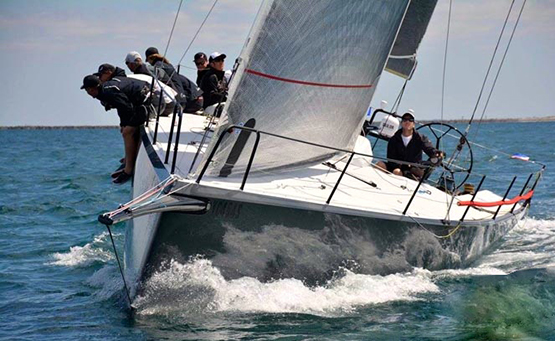
Her lines were drawn in the midst of the Wicklow countryside – the new Mark Mills-designed 45ft Concubine will have her first real test in the Hobart Race
For although the Hobart Race is of rather more recent date than the other classics such as the Bermuda Race and the Fastnet, they are biennial whereas the Sydney-Hobart has been an annual event ever since being founded in 1945, and thus has built up its mystique more quickly. As a result, some devotees log up an astonishing number of races to Hobart, and this year Tony Cable will be doing his 50th . This time round – as it has been for the past four Hobarts – he’s aboard Damien Parkes’ JV52 Duende, but he has been on many different boats, and in all he has raced to Hobart with 308 different crewmates over the years, so they’re going to need a very large premises for his reunion.
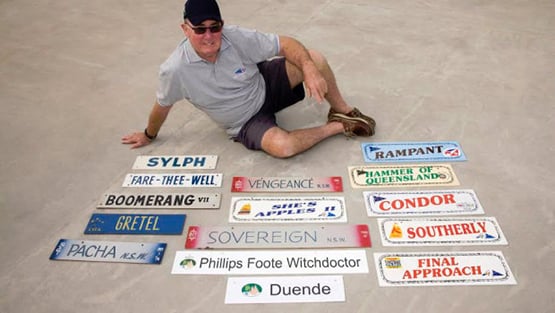
Tony Cable is doing his 50th Sydney-Hobart Race – these are the name plates of the 15 boats he has sailed on
The Sydney-Hobart Race started at the end of World War 2 when Sydney cruising men asked the great offshore racing legend Captain John Illingworth RN – who happened to be running the navy yard at Wooloomoolo at the time – if he’d be interested in a cruise-in-company down to Hobart over Christmas. He said he’d be interested in the offshore passage to Hobart, but only if they made it a race.
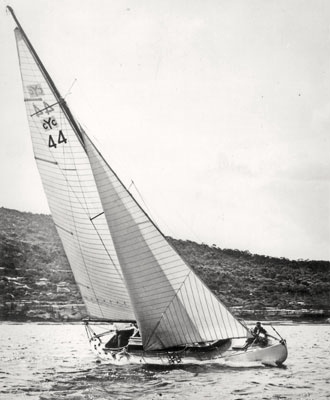
Rani (John Illingworth) was winner of the first Sydney-Hobart race in 1945
By the time it got going, he’d acquired himself a little locally designed and built sloop called Rani. Despite having one of the smallest boats in the fleet, Illingworth battled on through a proper Southerly Buster and then another gale, before he finally got to Hobart expected to be dog last in this new race, as Rani’s radio had packed it in shortly after the start. Thus they’d no word of anyone else at all, while they themselves had been posted missing.
But he found he was twenty hours ahead of the next boat on the water. He’d won overall by hours or even days, and it was a long time before all the fleet had got in. Every other entry had sought shelter of some sort. And one boat had even gone into port so that her crew could go to the cinema to pass the time before racing on south once the weather had improved. Be assured that things are different these days in the Rolex Sydney-Hobart Race
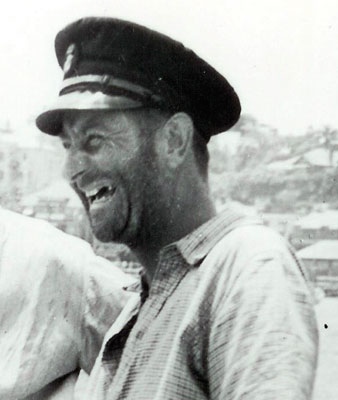
Captain John Illingworth looking more than somewhat weatherbeaten at the finish of the first Hobart race in 1945, which he won. He went on to win the Fastnet Race overall twice (in 1947 and 1949) with Myth of Malham.
Dun Laoghaire offshore sailor Kenny Rumball has won his class in the Tour de Belle-Ile Race onboard the Open 7.50m 'Cool Runnings'.
Rumball, the owner/operator of the Irish National Sailing School in Dun Laoghaire, was crewing onboard the Jochem Visser skippered yacht with Thorkild Juncker and Tom Whitburn. Rumball told Afloat.ie he found the big 500–boat French race fleet 'hard to comprehend'. See vid above.
The Tour de Belle-Ile is a sailing event created in 2008 and open to all sailing yachts measuring 6,50 metres or more, and is the French equivalent of the UK's Round the Island Race.
The Tour de Belle-Ile is around 41 nautical miles: starting from the middle of the bay of Quiberon (Brittany, France), rounding of Belle Île leaving the island to port and returning to the departure/finish line.
A month ago, Rumball finished sixth overall at Spi Ouest regatta in western France, on the same boat.
#spiouest – Dun Laoghaire's Kenny Rumball finished sixth overall at Spi Ouest regatta in western France yesterday. Rumball, who runs the Irish National Sailing School, was racing the Class 7.50 yacht, Cool Runnings with international yachtsman, Jochem Visser onboard. The crew suffered in the 12-boat fleet because they counted both an OCS and a DSQ in the 12–race series. Results here.
The Spi Ouest-France Intermarché, which ended in La Trinité-sur-Mer in 'perfect weather conditions' was the 37th edition of the regatta.
In 2016, Spi Ouest takes place from March 24 to 28.
#dinghycharter – At the end of the 2014 summer sailing season as we started to look towards the winter racing series and talk of the 1720s racing in the Dublin Bay Sailing Club's Turkey Shoot and Spring Series writes Kenneth Rumball. Our dinghy sailors started to ask what was for them? A bit of head scratching and it was decided that the INSS would charter out our fleets of Lasers and double-handed dinghies to both our junior and adult sailors. Not only would these sailors benefit from having access to a boat to race in but we also supplied an INSS support boat manned by Glyn Williams to give that extra bit of security and also to act as a coach boat giving feedback to our sailors and helping them to progress their sailing. The support boat was also there to support some of our 'own boat' sailors also giving them an extra helping hand.
The 2014-2015 series has been a huge success for our sailors, a shaky start last October where a lot of our sailors who had never raced before all of a sudden were thrown in the deep end and on a race track before they knew where they were. Kenneth and Alexander Rumball who raced in the Fireball and RS400 classes respectively were initially on hand to give helpful hints and advice after races and encourage all sailors along.
It has been fantastic to watch the progress of all our sailors throughout the series which culminated today in the final prize giving of the 2014-2015 series. There were some claims to Silverware from the INSS team with Lorcan Tighe claiming the first Feva trophy in the PY class, Alexander Rumball claiming third in the RS class and Kenneth Rumball and Brian Byrne claiming the overall Fireball trophy.
Plans are already a foot for the DBSC summer racing series, with our fleet available for charter.
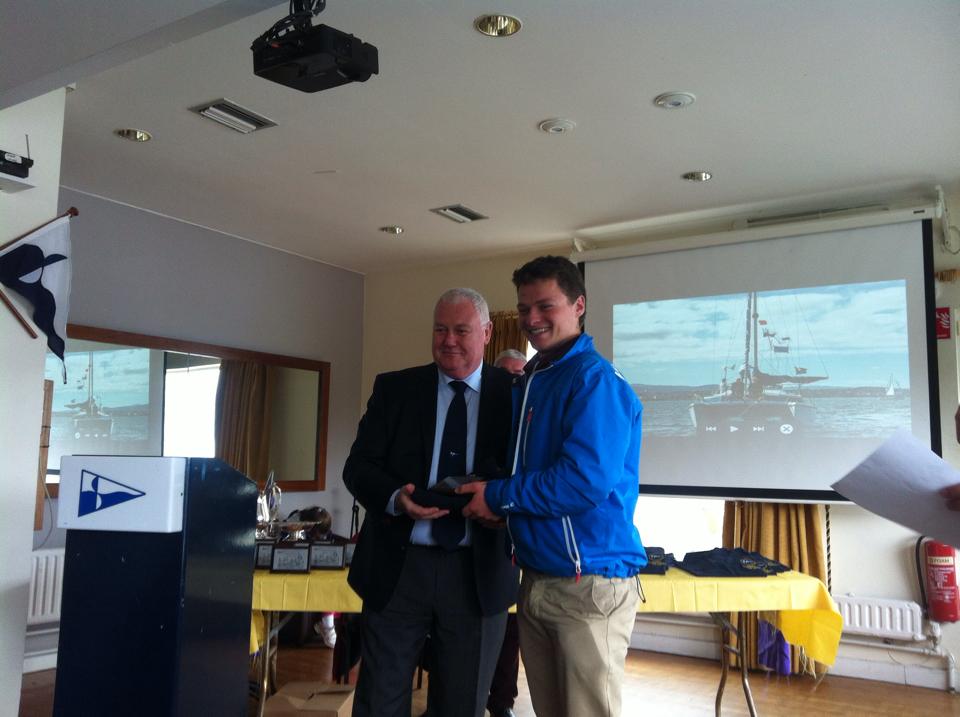
Alexander Rumball who claimed third overall in the RS Class
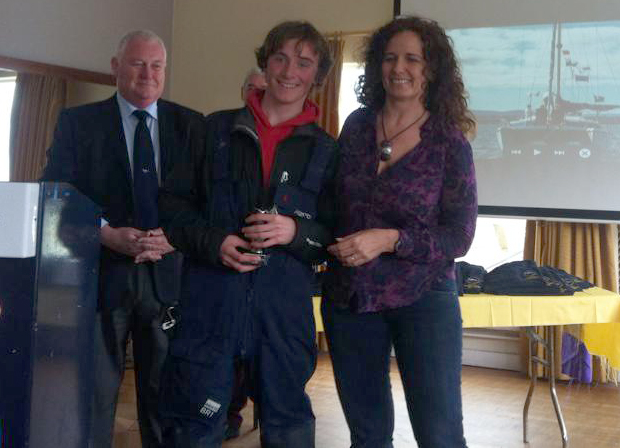
Loran Tighe of the INSS claims the Feva Trophy
Irish 'Breakthrough' Crew Fall Back in Sydney–Hobart Race
#rshyr – A joint Dublin Bay/Sydney crew are battling in strong winds to recover their mid–race third overall position after losing 22 places and first in division over the past 24 hours of the 628–mile Sydney–Hobart race.
The drop in performance – an estimated 1.5 knots off the pace all day – has prompted some of Breakthrough's shore crew to speculate that a torn spinnaker might be to blame.
Alternatively the easterly course chosen by Breakthrough might have contributed to a slower wind angle but for now there is no onboard report to explain the speed dip.
North-east winds are gusting up to 35 knots on the race course. A number of yachts have suffered damage including the dismasting of the Volvo 70, Giacomo.
The Barry Hurley led Breakthrough crew, that includes Dublin Bay sailors Kenneth and Alexander Rumball and Catherine Halpin, have slipped from third overall yesterday to 25th this morning with 200–miles left to the Hobart finish. The on–the–water race leaders have already finished in Hobart, Wild Oats XI took a record eighth win.
Just 24 hours earlier, as Breakhrough lay 33 miles off Gabo Island, the Irish crew were vying for the overall lead in the 70th edition of the race.
The slippage started last night around 11pm Irish time when the official standings revealed a drop to seventh overall. Hurley's crew maintained their class three lead despite being 1.5 knots off the pace but this morning – some ten hours later – the Beneteau First 40 crew has tumbled to 25th and is now tenth overall in a highly competitive 21–boat class three.
More on the race site here
For Irish Offshore Racing Sailors, 'Tis The Season To Be Sailing To Hobart
#rshyr – Tasmania is a medium-sized island in the Great Southern Ocean which is sheltered to the west only by South America. And as Tasmanians reckon skinny little New Zealand doesn't really provide a proper lee, they'll tell you their island is also sheltered to the east only by South America. So although it is at the same latitude in the south as Bordeaux in southern France is in the north, Tasmania's weather conditions – particularly the winds – can be much more extreme than they are in Bordeaux.
For sure, this lovely island can have some beautiful summer weather. But equally, it can serve up some very demanding sailing conditions. Thus the annual 628-mile Rolex Sydney-Hobart Race inevitably brings the fleet into increasingly hostile seas the further south they progress down much of the course. And the Bass Strait between Australia and Tasmania is a notoriously rough bit of water which has claimed lives in this event.
But then the twist in the tail is the final ten or so miles from the Iron Pot up the narrowing and increasingly flukey Derwent Estuary to the finish at the Hobart waterfront. This concluding crawl can test any sailor's sportsmanship as he or she sees a good position, hard earned over hours and days on a very rough sea, wafted away in calm spots and fickle zephyrs. Indeed, some hardened Hobart race veterans reckon the real contest finishes not even at the Iron Pot, but rather as you enter Storm Bay in the approaches to the Derwent Estuary, saying that it's just a lottery thereafter. But despite such criticisms, the race is one of sailing's great events. W M Nixon takes a look at this year's 70th staging of the classic, which starts in traditional style on Sydney Harbour in less than six days time.
If the annual Rolex Sydney-Hobart Race didn't exist, then world sailing would have to invent it. But happily, it's there already for our absorption and enjoyment. And in 2014 for its 70th staging, it's more relevant than ever in an era of instant global communication. When we remember that much more than half of humanity lives in the Northern Hemisphere and many of them are now in the depths of winter, the fact that there's this glorious and accessible sailing spectacle all ready to roll on screens worldwide, just as we're finally sated with Christmas and all its trappings, is a sanity-preserver for anyone interested in boats and sport.
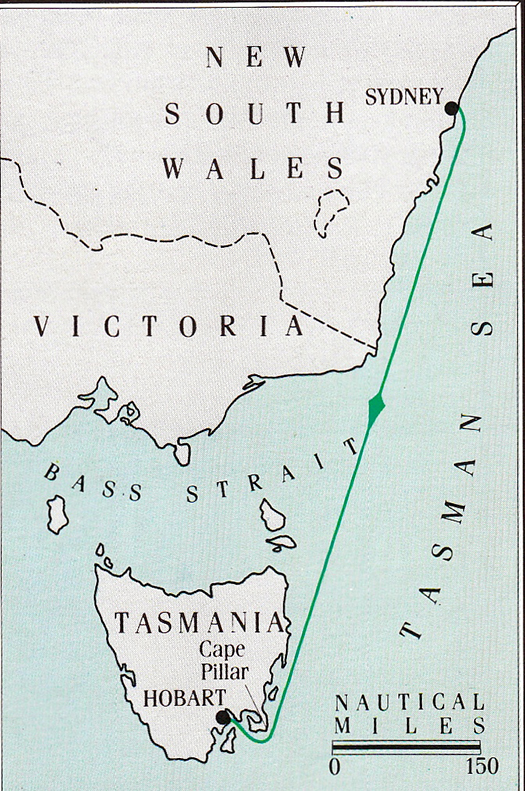
The great race's 628 mile course takes the competitors ever deeper towards the Southern Ocean with every mile sailed.
Of course there's Irish involvement in it at a specific level, with two boats in particular carrying our special interest. But at a more generous level, anyone who has the slightest interest in sailing cannot but be fired up by the wonder of an event in which some of the most advanced hundred footers in the world are swept up in a contest in which they will not only be in cut-throat competition with each other for line honours, but at the end, when all the calculations have been done, for dyed-in-the-wool offshore racing enthusiasts the real competition will be for the Tattersall's Cup, the hugely prestigious trophy for the overall handicap winner.
With 117 expected starters of all sizes from 33ft to 100ft, as the race gets under way each boat will have its own ideal set of conditions and circumstances to suit crew hopes. But as the contest continues, there'll be those who start to emerge in the leading group on handicap, and by the time they're in the final approaches, it is usually whittled down to about a dozen boats or even less which are in there with a shout for the Tattersall's.
But the line honours race for the Illingworth Cup – named in honour of the great British offshore racing skipper and innovator John Illingworth who first suggested the race in 1945 and won it too – now that's a different animal altogether. It's a real death or glory battle. And there's something specially entertaining and attractive about a no-holds-barred contest between boats you could like a lot, just at the time when the word is that the current flotilla of Volvo Round the World Racers may not be very likeable boats at all.
For we hear that the Volvo 65s are twitchy beasts, and not really fun to sail. To have a boat which turns round and looks at you is unfortunate. To have a boat which lies on its back and waves its legs in the air is unfortunate. But a boat that does both....? Oscar Wilde's Lady Bracknell said everything about such a situation.
So we'll return with relief to the crazy guys with the glorious big boats at the front of the fleet in the race to Hobart, for after the Volvo 65s, they're like a breath of fresh air. This is definitely not the territory of careful accountants and penny-pinching save-a-dime boatbuilding. We're looking at the stuff of legend. And the people's favourite has to be the veteran Wild Oats XI, marvellously campaigned by Mark Richards and his team of all the talents with the full support of the veteran owner Bob Oatley (86), whose wine brand of Wild Oats – one of many business interests – doesn't suffer any image problems at all when his boat of the same name wins yet again.
They talk of the Reichel Pugh designed super-slim Wild Oats XI as a "beloved old boat", but in truth she has been so continuously modified that you'd be hard put to say just what is original. The word is they've made her waterlines even narrower up forward – she used to be skinny, but now she's anorexic. As for last year's secret ingredient, the horizontal hydrofoil which, when deployed to lee, reportedly improved performance by up to 4% by making the boat better able to carry sail, for this year's race they tried making it even longer, such that it didn't entirely retract into the housing. But it seems that with a bit sticking out permanently on the weather side, it created more fuss than it was worth, so it has been shortened back to disappear entirely when not in use.
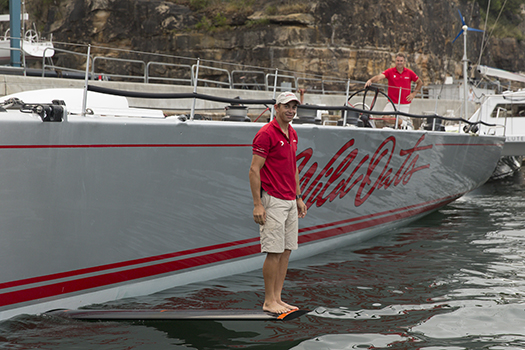
Wild Oats XI has so many bits and pieces sticking out of her hull that she has been compared to a Swiss Army Knife. This is skipper Mark Richards standing on the horizontal hydrofoil which, when deployed on the lee side, gives sufficient lift to significantly improve sail-carrying power. However, it has been shown that it has to be completely retractable into its housing when on the weather side, otherwise it causes unacceptable turbulence.
This conclusion on the downside of making the hydrofoil even longer emerged from some serious heavy weather sailing by Wild Oats off Sydney recently, when she was getting her final pre-Hobart race test and crew training. Heading back to port, with only about a quarter of the mainsail set in a very big wind, the silver arrow was making up to 33 knots. That will be food for thought for the four other hundred footers, the most challenging of which is of course Jim and Kristy Hinze Clark's new Comanche, just out of the wrappings, a hundred foot of total racer with Kenny Read as skipper.
The new girl on the block. American Jim Clark and his Australian wife Kristy Hinze Clark will debut their new hundred footer Comanche in the Rolex Sydney-Hobart 2014.
The same Kenny Read endeared himself to the Irish sailing community during the first Volvo visit to Galway five years ago, when he exited the dock somehow managing to look cool wearing a Paddy Hat that no-one else would be seen dead in. The boy is still busy, as he's worldwide president of North Sails, while his current main commitment afloat is to campaign the very extreme Comanche to the limit, with the Rolex-Sydney Hobart Race 2014 the first outing for real.

God be with the days.....five years ago, Kenny Read endeared himself to the people of Ireland by managing to look cool in this hat while exiting Galway Docks during the Volvo stopover. Photo: Failte Ireland/David Branigan
The hundred footers did have their first encounter a couple of weeks ago with the CYCA Solas Big Boat Challenge in Sydney Harbour, but racing boats this size in such relatively restricted water gives a somewhat skewed picture. Nevertheless the very experienced tacticians on Wild Oats still managed to finish first, as they did last year, but it was Comanche second quite a bit clear of Anthony Bell's Perpetual Loyal.
Once upon a time, Perpetual Loyal was very well known in Ireland, but that was in 2011 when she was George David's Rambler 100, and upside-down off West Cork. Until Comanche's appearance, Perpetual Loyal was reckoned the potentially fastest hundred footer of them all if she just could get enough wind in the right direction. But now the hundred footer field is wide open as a number of them have been undergoing major modifications of the kind you might expect to see on model yachts, but not on thirty metre hulls.

Can you see the join? The entire aft half of Rio 100 is entirely new, thanks to several months of major surgery in Auckland.
Thus the former Lahana, now American-registered, owned by Manouch Moshayedi and re-named Rio 100, simply had her entre aft half cut off, and replaced with a new wider stern section. Just like that. But you ain't heard nuthin' yet. The irrepressible Syd Fischer, shaping up to do his 50th Sydney-Hobart at the age of 87, decided that the hull of his hundred foot Ragamuffin needed some mods. A lot of mods. So he has just kept the deck and rig, but cut off the original hull, and replaced it with a new one from the same designer, Andy Dovell.
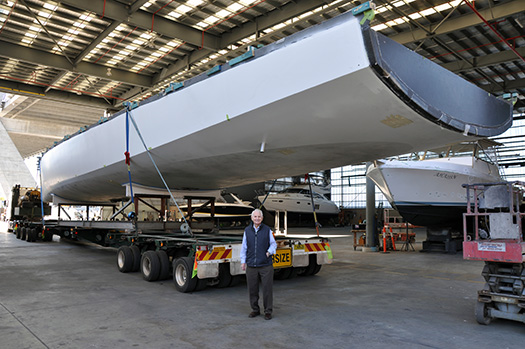
The incredible Syd Fischer, a sprightly 87-years-old, with the entirely new Andy Dovell-designed hull before it was fitted under the deck and rig of his previous hundred footer Ragamuffin.
So if next time you're on Sydney Harbour and a peculiar-looking hundred foot motorboat comes tootling past with a slightly lost air to her, you'll know why. She could swear that once upon a time she had a deep keel and a great big mast. But she's out and motoring about because there's no way Australians will let a redundant hundred foot hull go to waste. Meanwhile, the new raceboat hull has barely had time for testing, but we're assured all will be well, and the something old, something new Ragamuffin 100 will be there on the line raring to go against Wild Oats, Comanche, Perpetual Loyal and Rio 100 in the battle for line honours.
But as old Hobart hands will tell you, the real race is almost something else altogether. You'll have noticed that in mentioning the Solas Big Boat Challenge, we only talked of line honours. But it has an equally important IRC element as well, and two weeks ago the winner was Matt Allen's Carkeek 60 Ichi Ban, with Gordon Maguire the main man.

She may seem a plump girl by comparison with some other boats, but Matt Allen's Carkeek 60 Ichi Ban has been winning races, including the Solas Big Boat Challenge 2014. For the Rolex Sydney-Hobart 2014, skipper Gordon Maguire will be joined by ace Irish-born navigator Adrienne Cahalan.
And Ichi Ban's challenge in the Hobart race is even more Irish, as the Allen-Maguire team have linked up with Offaly-born Adrienne Cahalan to be navigator. One of Australia's top women sailors in almost any role, her navigational skills are legendary, and in the 2013 race she was navigating the 55ft Wedgetail to such good effect approaching the Tasmanian coast that they held the IRC lead, only for it all to come tumbling about their ears with a dismasting, which is hardly the navigator's fault.
So this time to Hobart, Ichi Ban really does have the dream team aboard. And though we still wonder if she's not just a little too plump in her waterlines forward to have that real cutting edge, the boat's results over the past year suggest that she has what it takes, and if the cards fall her way at all, she'll be clear to win.
Looking again at the top ten IRC boats in 2013, it's significant that apart from the freak presence of the hefty Swan 82 Nikata at 7th overall, only Ichi Ban at 8th overall was over 50ft long. The rest of the top ten were all 50ft or under, and the outstanding design was the evergreen Cookson 50, represented by both the overall winner Victoire (Darryl Hodgkinson), and the ninth placed Pretty Fly III (Colin Woods).
We in Ireland know well of the New Zealand-built Farr Cookson 50's brilliance through Chieftain (Ger O'Rourke), which later became Adrian Lee's Lee Overlay Partners, thus putting the Fastnet overall win of 2007 and the Caribbean 600 overall win of 2009 on the Cookson 50 winner-board before Victoire added the Sydney-Hobart win in 2013. It's some going for a design which first saw the light of day more than ten years ago.
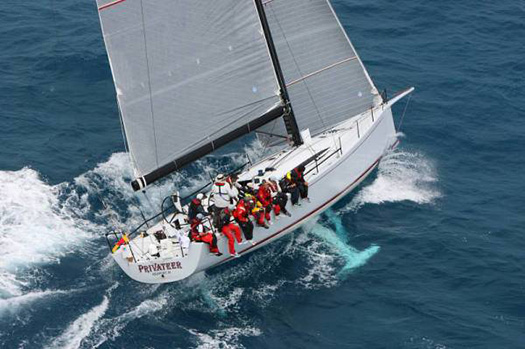
Privateer is one of the evergreen Cookson 50s, which have been consistently successful in the world's top offshore races for a decade
But as 2013's results show, doing well in the Sydney-Hobart has a huge element of horses for courses to it, and in 2010 the very new First 40 from Beneteau made a prodigious debut by taking first and second overall. They're still a very competitive boat, so not surprisingly there's five of them shaping up for the race to Hobart, and this is where the most direct Irish involvement comes, as Barry Hurley and his team have linked up with co-owner Mathew Vadas to put the beef in the crew of the First 40 Breakthrough. [Click to read Barry Hurley's preparations for this third successive Sydney–Hobart Race – Ed]
The same linkup saw Breakthrough take eighth in Class and 29th Overall in the 2013 race, but this time round Barry Hurley ships on board with the added experience of second overall and first in class in October's Middle Sea Race. With him to show that the boat is indeed sailing under the Dublin Bay Sailing Club colours are Catherine Halpin and Kenny and Alexander Rumball. And the word on the waterfront is that a shore support team not entirely unconnected with the Irish National Sailing School will be an enthusiastic presence in Sydney on December 26th. We look forward to hearing from them. Meanwhile, Happy Christmas everyone.
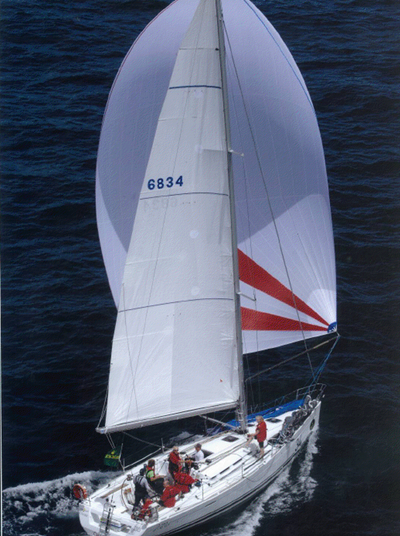
The First 40 Breakthrough will be racing under Dublin Bay Sailing Club colours in the Rolex Sydney-Hobart race 2014, starting December 26th
#VOR – Volvo Ocean Race fan and Irish Fireball champion, Kenneth Rumball, has won a trip to Miami, USA, to sail with Abu Dhabi backed outfit Abu Dhabi Ocean Racing. The 24-year-old, from Dun Laoghaire County Dublin, says the chance to meet his heroes and sail on the team's Volvo Open 70 race yacht, Azzam (determination), in the gruelling round-the-world sailing event is a dream come true.
Hoping to follow in the footsteps of one of his heroes, Abu Dhabi Ocean Racing's Irish bowman, Justin Slattery, a three-time Volvo Ocean Race veteran and event winner, Kenneth is relishing the chance to jump onboard and pick up some pointers from one of the sport's toughest professionals.
"I am a massive fan of the race and given the opportunity I would love to compete in it. I am very much looking forward to meeting Justin and all the crew of Azzam as well as the Abu Dhabi shore team; this is the pinnacle of the sport and I'm sure there is so much I can learn from them," said Kenneth, who runs and manages the Irish National Sailing, Powerboat School & Club, Eire's largest sailing school.

Kenny Rumball and Dad Alistair of the Irish National Sailing School are flying out to Miami
Kenneth entered a Facebook competition run by Abu Dhabi Tourism & Culture Authority , which manages the Volvo Ocean Race contesting outfit, to win an ultimate VIP trip to Miami for the global sailing event's seventh stopover from 18 until 20 May 2012.
Having started sailing aged four under the guidance of his father Alistair, who will join him on the Miami trip, Kenneth has gone on to represent the 'Emerald Isle' at top international level in various classes including the Optimist World Team, Corpus Christi Texas 2002, ISAF Youth Worlds Korea 2005 in the 420 Class and the 420 Junior Europeans in Lake Garda Italy in 2005, where he picked up the bronze.
A determined sailor and boat builder, Kenneth choose to hold off going into the Olympics to concentrate on his studies, but he is chomping at the bit to get some more offshore sailing under his belt so he can perhaps one day be a part of the Volvo Ocean Race, which ends in Galway, Ireland in July.
"I chose not to go down the Olympic route as I became too busy with studies in college. I have been competing at international level in the Fireball class since and have done some offshore classic races including the Rolex Fastnet Race and Rolex Middle Sea race this year as helmsman, bowman and trimmer in a semi-professional capacity. In the future I would like to gain more offshore experience and compete in the Volvo Ocean Race for sure, maybe this chance in Miami with Abu Dhabi might just be that springboard," said Kenneth.
No stranger to Azzam and the team's double Olympic medal winning skipper, Ian Walker, Kenneth was on the water when the Abu Dhabi team powered to victory in the 2011 Rolex Fastnet Race in the UK, where it smashed the monohull record on its first outing.
"I was in the same race as Azzam in the UK last year; she is a striking looking yacht. It'll be a totally different experience being onboard though, I can't wait," says Kenneth.
Having landed in Miami last weekend following the round-the-world race's sixth leg - a testing 4,800 nautical mile route from Itajai, Brazil, in which the team finished fifth - Walker and his crew now face the points-scoring In-Port Race on Saturday and the global sailing odyssey's Leg 7 start to Lisbon, Portugal, on Sunday.
Currently lying in fifth overall, the outfit – which boasts the first Gulf national to ever compete in the global sailing odyssey, Adil Khalid – is hoping to capitalise on its solid In-Port Race form, which has seen it win two of the stadium style races to date, in Alicante and at home in the United Arab Emirates capital last January.
Rumball and Moran Win Final Frostbite of 2011
#SAILING – The last race of the 2011 season for Irish Fireballs started under clear blue skies but with a cold aspect to the breeze which came from a westerly direction. As the afternoon progressed a distinct change in weather was evident with grey skies rolling in. It was yet another busy day on the water for the Frostbite fleet which boasts RS 400s and 200s, 420s, a 470, Mirrors, Lasers, IDRA 14s, Laser Vagos and of course the Fireballs.
There is a solid core of 12-14 Fireballs that have raced throughout this first series even though there are closer to twenty boats actually entered for the event. As advised in previous reports, the attraction of the Frostbites is that they don’t take up the entire day. All the participants keep their boats in the Dun Laoghaire Harbour complex which means that to make a 14:05 start, most crews assemble for 13:00 in order to rig and make the short sail out to the outer harbour. All four Dun Laoghaire waterfront clubs, Dun Laoghaire Motor Yacht Club, Royal Irish Yacht Club, Royal St. George Yacht Club and National Yacht Club are represented on the water and for this series we have also had Sligo Yacht Club and Howth Yacht Club represented. The expectation is that we may have some participants from north of the border in Series 2 in the New Year.
Last of the three fleet starts, the Fireballs had a competitive and clean start with boats distributed along the line and the form boats stacked down towards the pin – Messrs Rumball, Butler and Boyle – with Smyth, Cassidy and Miller mixing it with them.
Rumball/Moran, Butler/Oram and Boyle/Hurley were joined in the rounding of the first weather mark by Colin/Casey with Smyth/Bradley in close company. Rumball and Butler got distracted with each other to allow Colin/Casey to lead the fleet around the first gybe mark but thereafter the pecking order became very established with Rumball/Moran leading the fleet followed by Butler/Oram and Boyle/Hurley.
However, outside these podium places there was lots going on as Miller/Donnelly, Colin/Casey, Court/Syme, Smyth/Bradley and latterly Chambers/Butler joined battle to determine the next sets of places. There isn’t a great deal to choose between these crews off the wind so going upwind is where the places are made, and yesterday the choice of which way to go up the beat was difficult. Staying right appeared to get better breeze but the starboard tack hitch into the weather mark was fraught with twitchy gusts. Going left appeared to have benefits initially but then the breeze fell off as the mark was approached.
Though not consciously racing for the day’s mugs, the early bidders for that honour were Smyth/Bradley but they were always in close company with the other claimants – Court/Syme. Mugs are won at the finish line and with Court/Syme initially putting Colin/Casey and Miller/Donnelly between themselves and Smyth/Bradley, only let Colin/Casey through to keep an insurance in place for the race trophies. Mug winners last week, Luke Malcolm and Shane Diviney (Howth), were retirees this week with a ripped main – the vagaries of racing!!
|
Frostbites Sunday 18th December |
|||
|
1. |
Kenneth Rumball & Dave Moran |
15058 |
Irish National Sailing School |
|
2. |
Noel Butler & Stephen Oram |
15061 |
Dun Laoghaire Motor Yacht Club |
|
3. |
Andy Boyle & Barry Hurley |
14934 |
Royal Irish Yacht Club |
|
4. |
John Chambers & Hugh Butler |
14807 |
Royal St. George Yacht Club |
|
5. |
Neil Colin & Margaret Casey |
14775 |
Dun Laoghaire Motor Yacht Club |
In keeping with the Sunday before Christmas, there was an element of decoration to the fleet with Santa hats on display by some crews (Boyle & Hurley in particular) but the most significant pointer to the time of year was the tinsel that flew from the top baton and end of the boom of Neil Colin and Margaret Casey.
The Series 1 prize-giving was held in the DMYC which was busy and warm as a consequence. Overall prizes were awarded to the three fleets, PY, Lasers and Fireballs with the Fireball results as follows;
|
Frostbites Series 1 (pre-Christmas). |
|||
|
1. |
Noel Butler & Stephen Oram |
15061 |
Dun Laoghaire Motor Yacht Club |
|
2. |
Kenneth Rumball & Dave Moran |
15058 |
Irish National Sailing School |
|
3. |
Andy Boyle & Barry Hurley |
14934 |
Royal Irish Yacht Club |
|
4. |
John Chambers & Hugh Butler |
14807 |
Royal St. George Yacht Club |
|
5. |
Neil Colin & Margaret Casey Alaistair Court & Gordon Syme |
14775 14706 |
Dun Laoghaire Motor Yacht Club Dun Laoghaire Motor Yacht Club |
|
7. |
Louise McKenna & Hermine O’Keefe |
14691 |
Royal St. George Yacht Club |
Series 2 commences on Sunday 8th January 2012.
31 Boats Puts Irish Fireball Fleet on a High in Dunmore East
All the usual suspects were there, Messrs Butler, Rumball, Laverty, Bracken, McGrottys (x2), Miller, Smyth, Colin and Oram together with some that we haven't seen so much of this season - Rowan, Hickey, Court and Boyle.
Speculation was rife on the Friday evening with both Met Eireann and the locals promising breeze for the weekend. The question was how much breeze?
Three races were sailed on Saturday in wind that started off around the 13/14 knot mark and built progressively as the day progressed. Two Olympic courses were set for Races 1 & 2, with Simon McGrotty & Ruairi Grimes making an early declaration of their intent with a commanding first place in Race 1, carrying on where they left off in Howth at the Leinsters. Local man Michael Murphy, crewed by Alex Voye came second, with Francis Rowan & Conor Clany 3rd. Unusally, Rumball/Moran were back in 8th with Butler/McCarthy inan equally unusual place of 4th.
Race 2 saw a more normalised finishing order with Rumball/Moran, Murphy/Voye, Clancy/Rowan the first three home, followed by Butler/McCarthy, McGrotty/Grimes & Laverty/Butler. McGrotty/Grimes were in the running for most of the race but a capsize undid their quest for a place in the 1-2-3. However, by this stage the wind had come up and the capsize count was increasing. Finishers were down to 22 boats as prolonged capsizes and the growing breeze led some people to call it quits.
A windward/leeward race was set for Race 3 and completed on the water but was subsequently protested out on a procedural error by the race management team. And so the fleet was ashore early as the conditions dictated that a fourth race would be questionable.
The Class AGM took place at 18:30 on the Saturday evening followed by an exceptionally good meal in the clubhouse and the usual post-mortems on the day's proceedings. The Sea Area forecast at midnight on Saturday night did not offer much relief for the fleet and the seascape on the Sunday morning wasn't altogether inviting.
With only two races completed, the race management team decided to run two windward/leeward course closer to shore and of shorter length to try and get a four race series completed so that the fleet would have the benefit of a discard. The wind speed indicator on the committee boat was showing 16-18 knot as the course was being set and the fleet flew down to the start area in steep seas that had been thrown up by an ebbing tide pushing out against the opposing breeze. Still spinnakers were flying as the fleet made their way downwind to the start. Saturday had seen spectacular reaches on the Olympic courses, today would see equally spectacular surfing conditions.
With two races in the bag, Murphy/Voye had four points, McGrotty/Grimes had 6, Butler/McCarthy 8 and Rumball/Moran 9.
A very fast W/L race saw a 1-2-3 of Butler/McCarthy, Murphy/Voye & Rumball/Moran. McGrotty/Grimes had being doing well but another capsize saw them relegated to 5th. Laverty/Butler were as consistent as ever with a fourth.
With all races counting, Murphy/Voye were still leading with 6pts, Butler/McCarthy were 2nd with 9pts, McGrotty/Grimes had 11pts & Rumball/Moran were on 12.
By this stage the wind was starting to creep up a couple of knots and with the tide about to turn the expectation was that the seas would subside a bit. Unfortunately the number of starters was down to 15 at this stage. Again the conditions were exhilarting downwind and the ability to stay upright was a key factor to getting a significant finish. Rumball/Moran upped their performance to take a comfortable win on the line, followed home by Butler/McCarthy, and McGrotty/Grimes. Murphy/Voye sailed their worst race to score a 4th, which effectively cost them the overall title.
This left Rumball/Moran as the 2010 Munsters Champions with Murphy/Voye in 2nd place, followed by Butler/McCarthy.
In the Silver fleet, newcomers Luke Malcolm and Shane Divney won with a 22, 12, 12, 7 series which saw them in 11th place overall. Luke sailed the Leinsters in a borrowed Fireball and has since purchased hos own Fireball and this was his first outing in a competitive regatta - bodes well for the future. Second in the Silver fleet was Ciaran Harken and walet Walsh (13th overall), with Cearbhailldaly & Martina Michels third.
This was a physically challenging regatta and easily had the strongest wind conditions we have had this season. Not since Lough Neagh in 2009 have we had quite so much breeze. However, at the start of the weekend it was great to see so many Fireballs on the water, 31, our highest entry for the year.
The AGM was a constructive affair with a lot of comment on how we manage our domestic season next year with a World Championships down for decision in Sligo in the second half of June. Attempts to get regatta dates pencilled in that bit earlier in the light of the June dates haven't been altogether successful and Saturday night's meeting probably means we are going to have to put our thinking caps on again. There was no real change in the committee structure, Siobhan Hayes has stood down as Silver Fleet Class Captain after a number of years in the post and will be succeeded by Barry MacDevitt. We have also lost the services of Daire McNally & Marguerite O'Rourke who have/will be relocating away from Ireland and we thank all three of them for their services while they were on the committee. The bulk of the committee have indicated their willingness to continue and the Class Captains at Club level will be resolved in the next few weeks as they have their own meetings.
The focus of Fireball sailing now moves onto the Frostbites which will be starting in October.





























